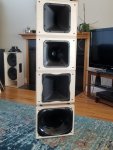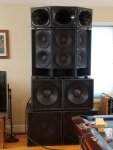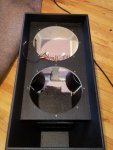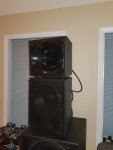Been working on a modular, easily array-able, mid-high setup, designed for ground stack use.
Two 12” mid drivers are in one box, and a BMS CD is in a second box that fits on top of the mid box.
The drivers are the same as in the PM90 / 60 …. rcf MB12N351 and BMS 4594HE.
The two boxes together look like a large JTR 3TX.
Basically, I simply took things I’ve learned from studying Peter’s DIYs and Jeff’s 3TX, and put it into a form to meet some specific goals.
Goals being: getting a ground stacked horn as high as possible, separating the horn from the mid to allow easy swapping of horns and compression drivers, easy arraying, ...and keeping anything I have to lift up high below 50 lbs.
The boxes are 40 degrees (as like pie wedges), which came from best splay angle I was able to measure for the xti-1464 .
The size of the high boxes was designed to barely hold the xti-1464 with the 4594HE. The other horns and CD’s I have are all smaller, and can easily be interchanged.
A pict with different horns is below.

The mid box matches the dimensions of the high box, other than height of course.
Put together, its 47”H x 16.5” W front x 14.5” D (119 x 42 x 37) 6” wide at rear
Mid box w/o grill 47lb. High box 23lb.
The high box has front rubber feet that nest into routings on the mid box, along with a rear jack foot on the high box to vary downward tilt..
On top of my labsubs or orbitshifters, the horn ends up about 7 ½ feet high at center.
I can gain 2 more feet of height pretty easily, by adding some diy 18” subs into the middle of stack.
(The diy subs sum almost perfectly with the hornloaded subs.)
A pict of 3 of the modular stacks is below. I figure first stack (with xti1464) is 60 degrees, and each incremental stack adds 40 degrees.

So I can go 60, 100, 140 degrees H pretty easy.
I haven’t yet measured multiple stacks outside. So far, indoors is looking like really smooth H coverage. And it's crazy powerful....I mean it's almost like 3 DIY60s arrayed....I measured efficiency, modular mid box vs the DIY60 mid, and was pleasantly surprised to find the modular was down only 0.3dB....100-650Hz.
I know there’s no way the vertical coverage/directivity can match the DIY 90 /60, but that’s a tradeoff I decided I could live with…..
Can't wait to test/listen outdoors.
Anyway, I realize this is a project that’s unlikely to generate a lot of interest, given its unusual nature…but I wanted to post it on this forum now that the new bulletin is running, and kinda say thanks again, to Peter, Don, the forum itself, everyone... for the ongoing education that’s let me play around and try something like this…
Best, mark
Two 12” mid drivers are in one box, and a BMS CD is in a second box that fits on top of the mid box.
The drivers are the same as in the PM90 / 60 …. rcf MB12N351 and BMS 4594HE.
The two boxes together look like a large JTR 3TX.
Basically, I simply took things I’ve learned from studying Peter’s DIYs and Jeff’s 3TX, and put it into a form to meet some specific goals.
Goals being: getting a ground stacked horn as high as possible, separating the horn from the mid to allow easy swapping of horns and compression drivers, easy arraying, ...and keeping anything I have to lift up high below 50 lbs.
The boxes are 40 degrees (as like pie wedges), which came from best splay angle I was able to measure for the xti-1464 .
The size of the high boxes was designed to barely hold the xti-1464 with the 4594HE. The other horns and CD’s I have are all smaller, and can easily be interchanged.
A pict with different horns is below.

The mid box matches the dimensions of the high box, other than height of course.
Put together, its 47”H x 16.5” W front x 14.5” D (119 x 42 x 37) 6” wide at rear
Mid box w/o grill 47lb. High box 23lb.
The high box has front rubber feet that nest into routings on the mid box, along with a rear jack foot on the high box to vary downward tilt..
On top of my labsubs or orbitshifters, the horn ends up about 7 ½ feet high at center.
I can gain 2 more feet of height pretty easily, by adding some diy 18” subs into the middle of stack.
(The diy subs sum almost perfectly with the hornloaded subs.)
A pict of 3 of the modular stacks is below. I figure first stack (with xti1464) is 60 degrees, and each incremental stack adds 40 degrees.

So I can go 60, 100, 140 degrees H pretty easy.
I haven’t yet measured multiple stacks outside. So far, indoors is looking like really smooth H coverage. And it's crazy powerful....I mean it's almost like 3 DIY60s arrayed....I measured efficiency, modular mid box vs the DIY60 mid, and was pleasantly surprised to find the modular was down only 0.3dB....100-650Hz.
I know there’s no way the vertical coverage/directivity can match the DIY 90 /60, but that’s a tradeoff I decided I could live with…..
Can't wait to test/listen outdoors.
Anyway, I realize this is a project that’s unlikely to generate a lot of interest, given its unusual nature…but I wanted to post it on this forum now that the new bulletin is running, and kinda say thanks again, to Peter, Don, the forum itself, everyone... for the ongoing education that’s let me play around and try something like this…
Best, mark





